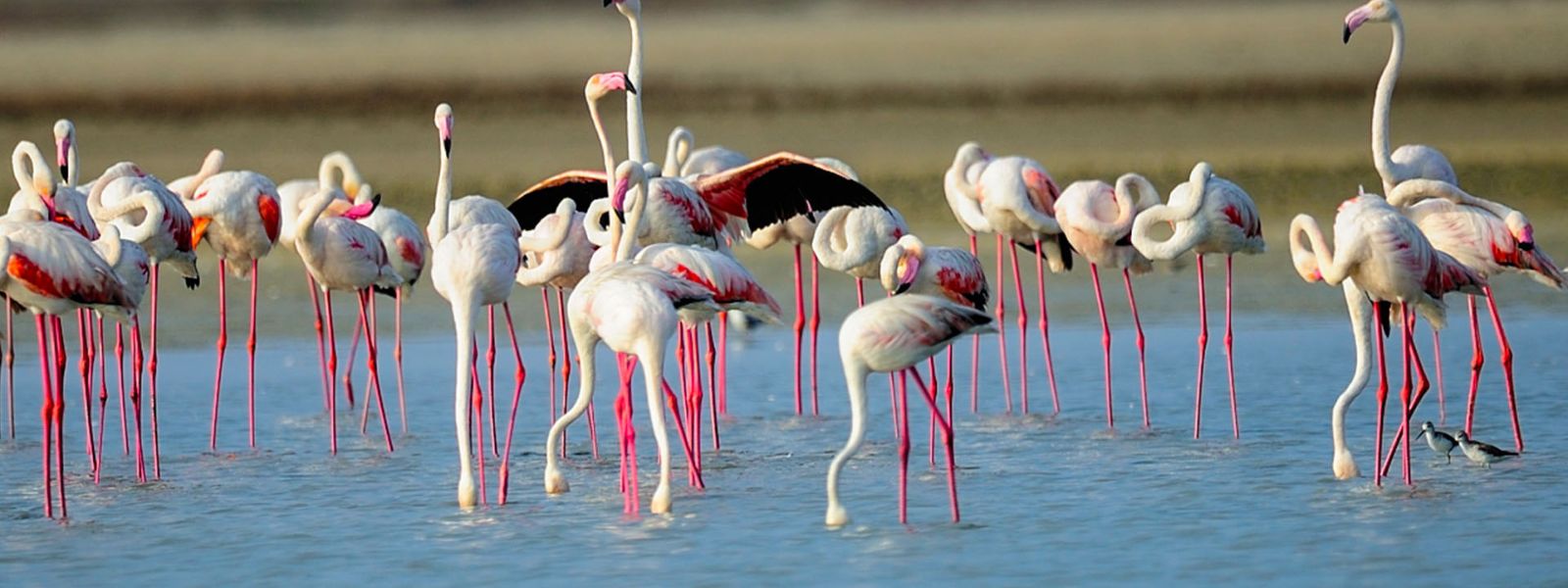.webp)

Turbulent Times Ahead: Migratory Birds at Risk Due to Proposed Wind Power Project?
COLOMBO (News 1st); In the midst of discussions surrounding the integration of Sri Lanka's national electricity system with India's, significant attention has been drawn to the Mannar wind power project.
Of particular concern in these deliberations has been the potential environmental ramifications of the Mannar wind power project, alongside its anticipated economic implications for the nation.
Renewable energy initiatives, which mitigate carbon emissions and provide cost-effective electricity, are commendable.
However, to ensure both affordability and environmental sustainability, it is crucial to consider environmental impacts.
Neglecting this aspect may hinder the achievement of renewable energy’s fundamental goals.
What is going to take place in Mannar?
The construction of 500 megawatt wind and solar power plants is ready to get underway in the regions of Mannar and Punarin. This ambitious project comes with a total investment of 442 million US dollars.
The combined facilities are expected to produce a substantial 250 megawatts of energy. Notably, the wind farms in Mannar will contribute significantly to this capacity.
On March 11, 2022 the project contract was formally executed.
Adani Green Energy, an entity within the Adani group in India, is involved in the project, and their involvement extends to both investment and implementation.
As per a Cabinet Paper, the Government of India had proposed Adani Green Energy as the ideal partner for this venture.
Furthermore, the project is being considered under a government-to-government framework, as highlighted in the relevant cabinet paper.
Remarkably, the project was awarded without a competitive bidding process.
Mannar, is strategically positioned as the closest point between India and Sri Lanka, and coastal land in the region was allocated for the project.
This area, known for its natural beauty and historical value, holds immense promise.
Mannar boasts rich biodiversity and valuable mineral resources.
Additionally, the 16 islands connecting Rameswaram in India to Sri Lanka are anchored in the Mannar region.
Among these islands, the 8 that belong to Sri Lanka have been designated as Adam's Bridge Marine National Park by the Wildlife Conservation Department.
Simultaneously, India has declared its 8 islands as the Gulf of Mannar National Park.
The project site lies close to the narrowest sea border between India and Sri Lanka.
Scientific research has already confirmed the presence of natural gas reserves in Mannar.
How is the selection of Mannar for a wind power project leading to an issue?
Experts well-versed in the subject matter are examining the Mannar Renewable Energy initiative from dual perspectives.
One is Economic Implications, and the other is Environmental Considerations.
Dr. Jagath Gunawardena, an esteemed environmentalist and legal expert, recently emphasized a critical concern during the Mawatha program.
Despite Mannar’s selection as the project site, he contends that there exist numerous other locations with substantial potential for wind power implementation.
"There are other locations across seven other districts with high potential for this project, and Mannar is not one of them. The project should go to the site with the highest potential. They must first set up these projects at those sites. Is it justifiable to award the project to Adani, at a time when Mannar has mid- or low-potential?," he questioned.
Dr. Jagath Gunawardena also raised concerns over the allocation of land for the project.
"The project comprises 52 Wind Mills, and they want 150 hectares for roads, and in total 200 hectares. If you do the math, each Wind Mill will occupy three hectares of land which is around 7 acres. There is a concealed aspect into this project," he added.
A pressing environmental issue has come to the forefront, drawing attention to Sri Lanka's pivotal position within the Central Asian Bird Flyway.
As one of the southernmost waypoints along this migratory route, Sri Lanka plays a critical role in the conservation and sustenance of avian populations.
Mannar, in particular, stands out as a significant destination within this flyway.
Professor Sampath Seneviratne, a distinguished researcher, has dedicated his scientific efforts to understanding and documenting this intricate ecological phenomenon.
"Some of the birds from Mannar, and Pesalai migrate to Europe to lay their eggs and return after the eggs hatch with their young. They stay here for around six months, in areas rich in fish populations. Around 15 million birds from 30 different countries migrate using eight routes, and one of those routes is the Central Asian Bird Flyway. Sri Lanka is located on the edge of that route. So, this will lead to a complete end to migration of birds from around 30 countries. This is a highly eco-sensitive region," he elaborated.
How will wind power projects impact bird migration?
"The length of a blade reaches 180 meters at the highest point. Then it turns for around 20 meters each second. That become an issue for the birds. The proposed project is located in the middle of the Adam's Bridge Marine National Park, and the Wankalai Wetlands. When one takes a look at the Environment Feasibility report, it has been prepared to facilitate this project," explained Professor Sampath Seneviratne.
Dr Rohan Pethiyagoda, a respected biodiversity scientist has been vocal about this.
"These 52 gigantic turbines, each one 220 meters tall, these will be the third highest structures in Sri Lanka. And they'll be located in the heart of Mannar Island, which is one of the most important bird areas in the world. Millions of birds, more than 120 species from across the Northern Hemisphere, some of them from as far away as the Arctic Circle, migrate southwards to Manna every winter. It is primarily for that reason that the island is surrounded by protected areas like Adams Bridge Marine National Park, Madhu National Park, the Vankale Sanctuary, Giant's Tank Sanctuary, and the Wadathal Thibu Nature Reserve. And we know that wind turbines kill hundreds of thousands of birds every year. They've accumulated reams of valuable data. And they've put it all in the public domain. Not just that, but they've fixed tiny satellite transmitters to the birds and tracked their movements across the world. They know precisely how and when birds migrate and which routes they use. In 2016, despite warnings that high tension power lines across bird corridors kill birds, The CEB, better than funded by the Asian Development Bank, decided to erect 220 kilovolt high tension overhead transmission lines across the Vankalai sanctuary. There again, several scientists, including myself, warned of the harm to birds and the unique wetland habitat. Since then, these cables have been killing threatened species of birds by the hundred," he explained in lenght on YouTube.
What was revealed from the EIA prepared with regard to the Mannar Wind Power Project?
This report is now in the possession of the Central Environment Authority.
"This report contains information on the impact that Wind Power Plants pose on migratory birds. We will have to consider that in the technical evaluation. The CEB will also consider the data on birds, and how they have been used in preparing this report. We will be appointing a separate team for this," said Dub
N. S. Gamage - Deputy Director General of the Central Environment Authority.
The report also produces solutions to the issue.
"The EIA produces a separate zone. In addition, it proposes to stop the turbines during bird migration, and to use radar for this purpose. This will be an automatic stoppage of the system, and that is what is mentioned in the report," said the CEA Official.
An additional critical consideration in this context pertains to the tourism industry.
Notably, there has been a surge of tourists who travel to this area for the sole purpose of observing this natural phenomenon.
This begs the question: at a time when Sri Lanka is desperately trying to expand its tourism potential, will those attract to these migratory birds still visit Sri Lanka to look at a wind farm?
The Central Environment Authority has announced the formation of an expert committee tasked with impartially evaluating the proposed project.
Their decision, expected in the future, holds significant implications.
While renewable energy initiatives are commendable, we must tread carefully.
If we compromise a delicate ecosystem in the pursuit of such projects or fail to ensure equitable benefits for our nation’s economy and citizens, we face a grave dilemma.
These decisions reverberate across generations.
We bear the responsibility to thoroughly investigate and transparently report the ground reality.
The consequences—both positive and negative—affect our fellow citizens directly.
Informed awareness is paramount.
Other Articles
Featured News





.png )

-798416_550x300.jpg)
-798410_550x300.jpg)








-797273_550x300.jpg)


















.gif)